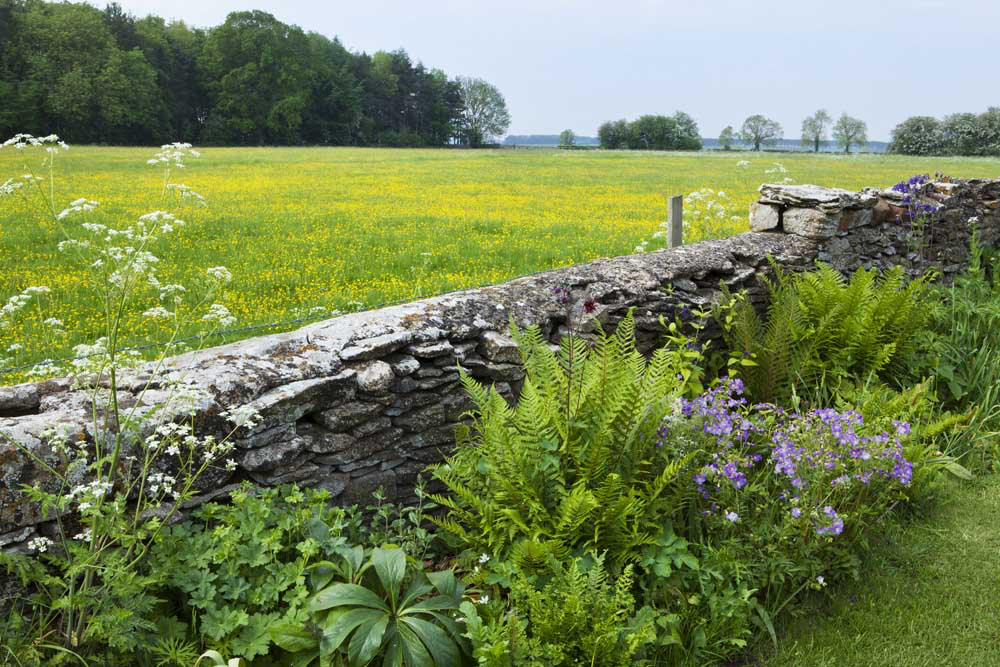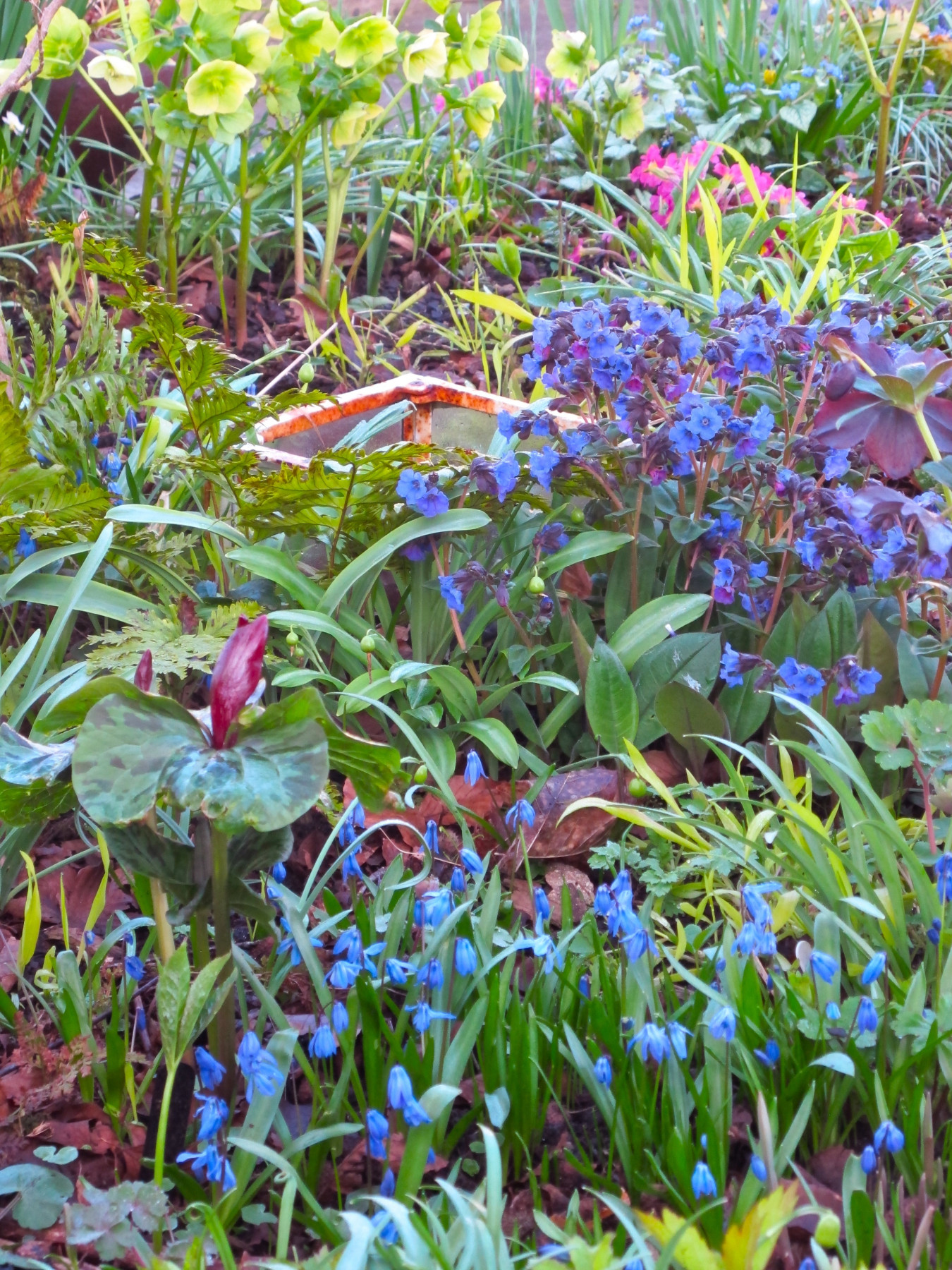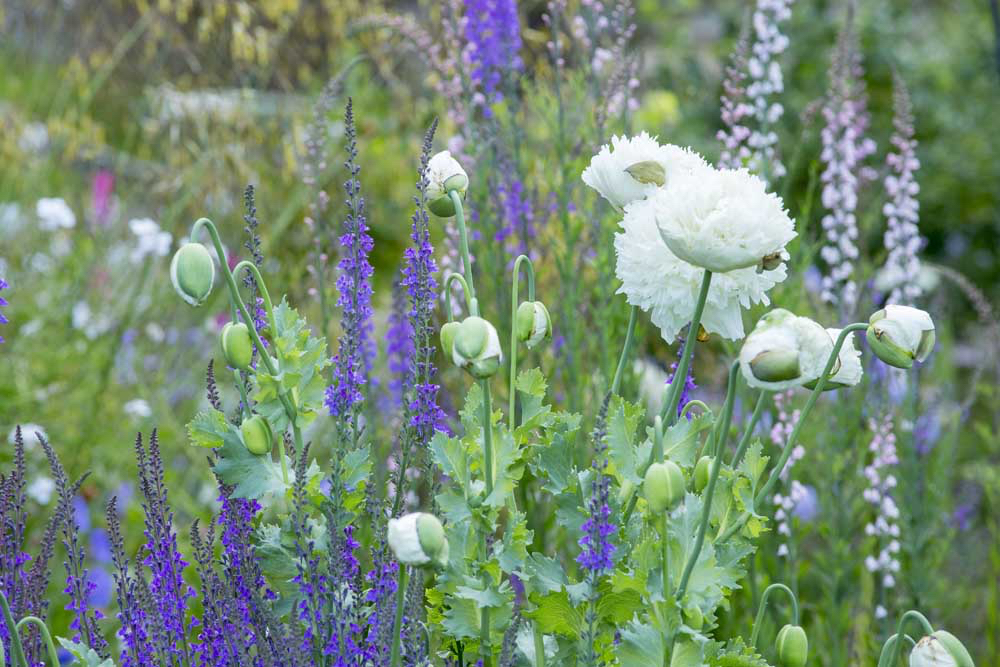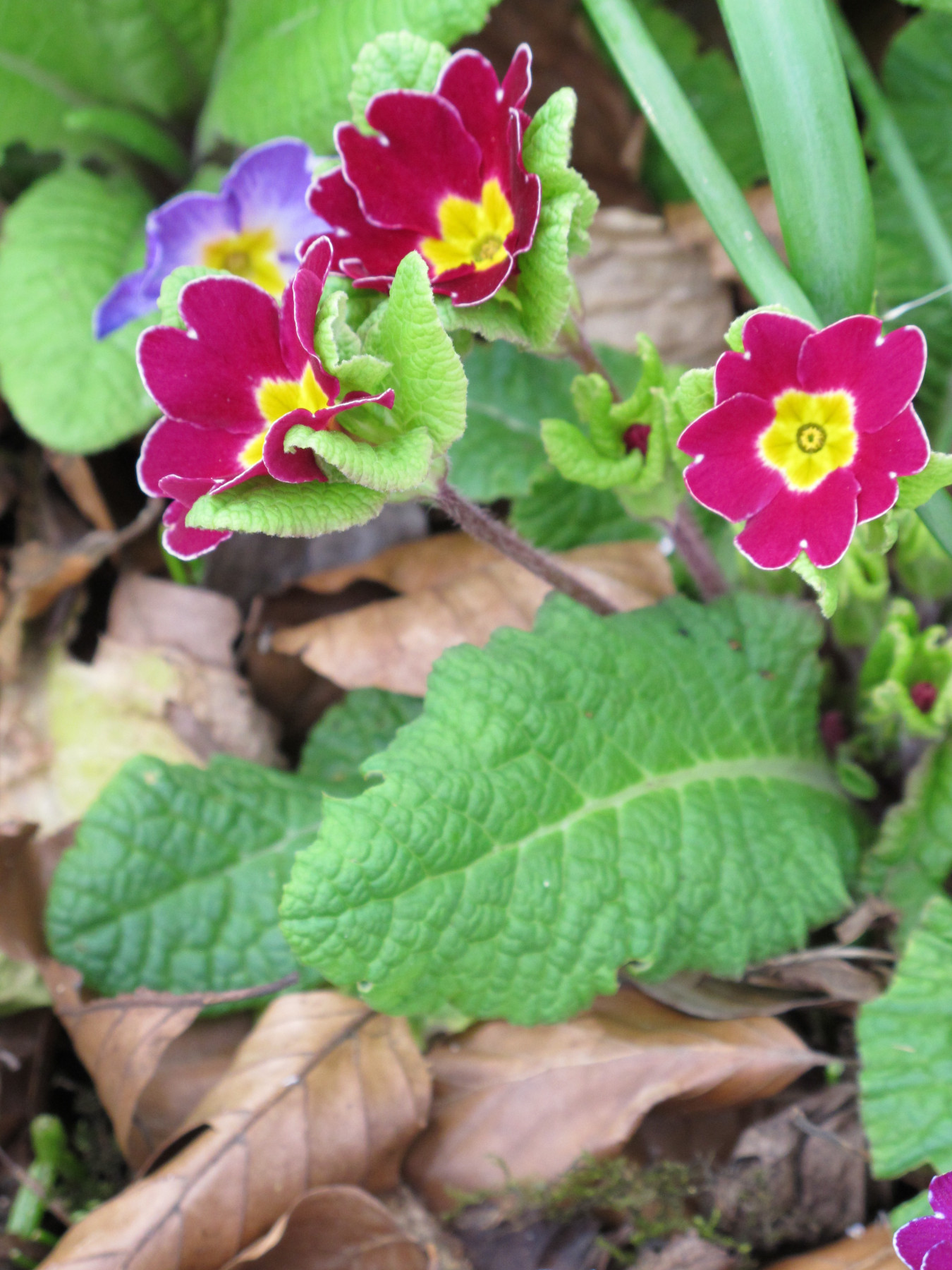
When I started gardening, in the 1960s, the first thing I did was a parks and gardens inspired rose border containing twelve leggy hybrid teas of different colours. These unhealthy beasts lost most of their foliage by midsummer and they all flowered at slightly different times and at slightly different heights. However, my biggest crime was to bed out alternate white alyssum with blue lobelia around the edges. I still cringe when I remember it, as restricting as a Victorian corset.
The crescent-shaped bed was too narrow for the tall roses, only three feet wide, and I soon realised that narrow borders are a complete no-no because there’s no scope to make them interesting! I also learnt to be selective. If you’re mass planting roses for instance, go for the same variety if possible and always avoid hybrid teas. They’re upright and lack any elegance on the whole, although I make an exception for Harkness’s blush-white ‘Chandos Beauty’ and it’s more champagne-tinted offspring ‘Mary Berry’ because they cut so well.
A good garden mustn’t be too man-managed either, but standing back needs a level of confidence. The person who plants their tulips in a regimented style will never have a great garden, because although that’s fine in the Keukenhof in Holland, it’s wrong in most private gardens. We can’t afford to have a display of tulips and then nothing to follow on. We have to have a succession waiting in the wings.
I’ve also learnt that a garden has to chime with its surroundings and Spring Cottage is surrounded by fields and sheep. In the meadow beyond the wall, the bulbous buttercups open their lacquered flowers to create a golden sheen in April and then the sorrel flowers appear, like stewed rhubarb without the custard. I don’t allow either of these too much of a stronghold in the garden, so when the seeds are carried on the prevailing south westerlies (as they inevitably are) they’re removed at an early stage. The long grass on my side of the wall marries into the meadow on the other side.

My garden is not London-smart, or any smart come to that, it’s a relaxed country garden of roses, peonies, hardy geraniums and so on. No pleached hornbeams here, just low stone walls in different degrees of decay. There are no cannas, no colourful large-flowered dahlias, or tree ferns from the southern hemisphere, or glorious gladioli. If I feel that kind of madness coming on, I abuse the allotment instead, much to the annoyance of the Best Beloved. He would rather plant more sweetcorn.
I like my plants to do the talking and put themselves about a bit. I have a great many Scilla siberica seedlings springing up in one rather dark corner, their cobalt-blue flowers creep through spring woodlanders. Under witch hazels. Like many species bulbs, the ones with two Latin names only, these spread by self-seeding rather than by offsets so I just let them get on with it and they’re a delight in April. Wild daffodils, (Narcissus pseudonarcissus) and swept back cyclamineus narcissi (N. cylamineus and Snake’s-had fritillary ( Fritillaria meleagris) spread by seed so don’t remove the heads after flowering. Leave them to it!
I’m not quite as happy about Scilla bifolia, because the seedpods are like male testicles and can wreak the same sort of havoc ladies. They infiltrate large areas, so I try to castrate these as they fade. The spring-flowering Cyclamen coum and the autumn-flowering C. hederifolium are allowed to produce lots of seeds and the ants roll them around as they lick away the stickly coating. They end up far away from their mothers and the Best Beloved itches to separate them from the siblings or shuffle them about, but I resist. After all, this is THE man who weeded out my black strappy Ophiopogon because it was creeping through my sliver border. The fact that it had taken me ten years of to encourage just that, counted for nil ladies!
I like a swathe and I allow lots of self-seeders to do their own thing, especially annuals, although I remove roughly seven in ten of the more bounteous ones. Poppies and nigella could take over the world. One poppy head can shed 40,000 seeds, but the thing with opium poppies ( Papaver somniferum) is you never quite know what you’ll get. One year you’ll have double white opium poppies galore, like a series of cockatoos in flight amidst deep-blue larkspur and the occasional orange calendula. The next year, dull maroon poppies appear and nothing else. Serendipity can definitely back fire.

I do remove the seed heads from my prized and expensive hellebores, because these highly bred plants are unlikely to produce great seedlings. Producing lots of seed also drains a plant of vigour and hellebores are hungry plants. Despite my best efforts I often spot a hellebore seedling lurking in the woodland border but I mostly leave it there.
I’m reminded of a garden talk given by a Scottish rock garden enthusiast called Ian Young. He had been collecting and planting rare snowdrops, erythroniums, crocuses, narcissi and many other spring treasures. Many a rock gardener would add a label and then deadhead to prevent self-seeding and the garden would be ultra-neat. Ian allowed his plants to produce seedlings over many years so they formed a natural swathe. More importantly, the pollinators created floral diversity so the flowers came in different shades and flower forms and they popped up in strange places.
I do allow my snowdrops, trilliums and erythroniums to form seeds and do their own thing, hoping for something magical to appear. However, I can’t bear to ditch the labels, in case I lose the names, and the Best Beloved is always telling visitors that I have the National Collection of white labels

I’m much less fussy about labelling primroses, although I never intended to grow quite as many of them as I do. The lower part of my garden lies damp in winter and primroses thrive there so every time I saw an interesting primrose, I planted it without its label. I planted neat doubles, gold-laced ones, hose-in-hose primroses with one flower set inside another and Jack-in-the greens. The latter have flowers surrounded by a collar of leaf, like choirboys commissioned by the Green Man. I have monstrous Jackanapes primroses, with leaves that are like petals and I let them mix and match and then look out for interesting seedlings.
Winter evenings in front of the television are often ruined by me, scrabbling about in old envelopes and cleaning up seed heads collected last summer, hopefully with a label. They include tall French marigolds, antirrhinums, dieramas, verbascums, teasels, various foxgloves and a lovely little pink or purple perennial named Linaria triornithophora, literally three birds flying. Some will take their time
By early March, I’ll be in my Hartley greenhouse sowing away. I’ll be pricking out my autumn-sown umbellifers such as Orlaya grandiflora, and potting up tender cuttings. I get lost in my own little word and, outdoors, seeds will be germinating where they want to. In cracks, crevices, hotspots and in the woodland and the funny thing is, it’s the self seeders that give me the most pleasure. They’re like visitors, you didn’t expect to see, an added bonus when they turn up!



